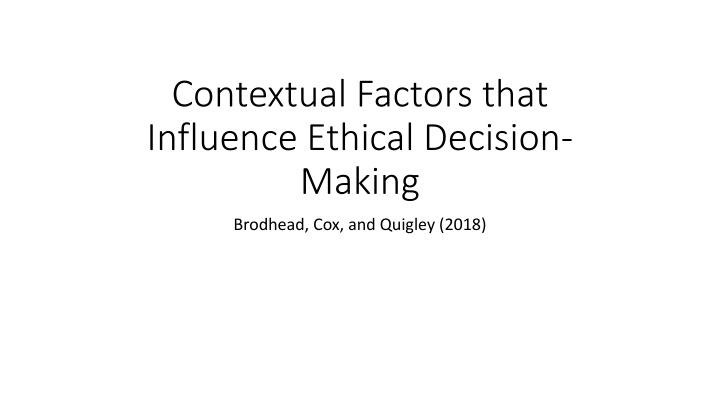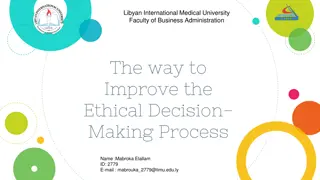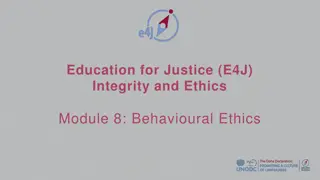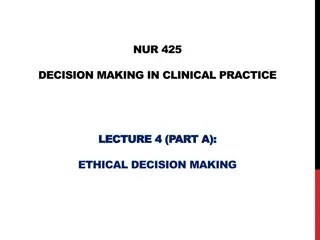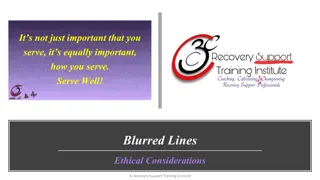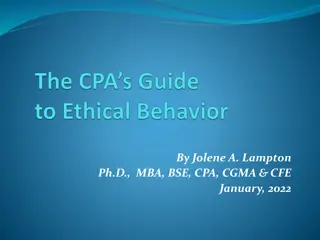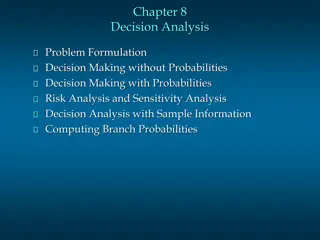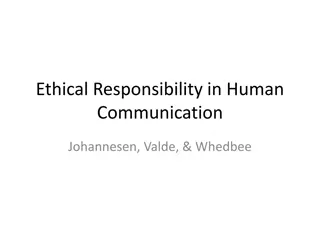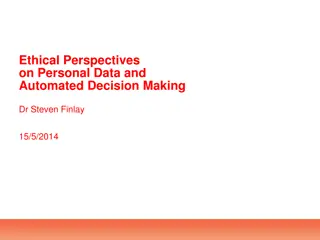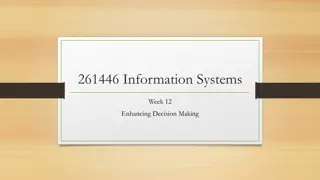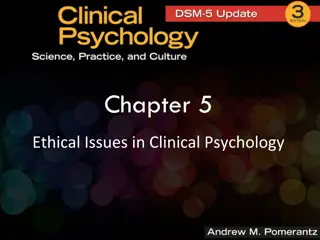Influence of Context on Ethical Decision-Making
Ethical decision-making is explored in relation to contextual factors influencing behavior. The chapter overview delves into laws and principles of behavior that shape ethical responses in choice contexts. Basic research on choice behavior examines the impact of available response options and reinforcement schedules. Understanding the relationship between response frequency and obtained reinforcement sheds light on decision-making processes. The allocation of behavior based on reinforcement amounts, matching law, and temporal preferences is highlighted within the research.
Download Presentation

Please find below an Image/Link to download the presentation.
The content on the website is provided AS IS for your information and personal use only. It may not be sold, licensed, or shared on other websites without obtaining consent from the author.If you encounter any issues during the download, it is possible that the publisher has removed the file from their server.
You are allowed to download the files provided on this website for personal or commercial use, subject to the condition that they are used lawfully. All files are the property of their respective owners.
The content on the website is provided AS IS for your information and personal use only. It may not be sold, licensed, or shared on other websites without obtaining consent from the author.
E N D
Presentation Transcript
Contextual Factors that Influence Ethical Decision- Making Brodhead, Cox, and Quigley (2018)
Chapter Overview Ethical decision making is behavior thus a function of the same laws and principles that govern all behavior Ethical decision-making involves a choice context An overview of basic research on choice behavior Factors that affect clinical decision-making
Ethical Decision-Making Laws and Principles of Behavior
Ethical Decision-Making The science and practice of behavior analysis emphasizes the importance of consequences and their effect upon future behavior A class of responses might be labeled as ethical if it matches group values Ethical responses are selected by environmental variables like any response
Ethical Decision-Making A choice context exists when two or more responses are available The behavioral processes that may affect the likelihood that people engage in one response over another have been studied e.g., matching law, discounting, demand Despite the abundance of research on choice, little attention has been given to ethical choice contexts
Basic Research on Choice Behavior
Basic Research on Choice Behavior Choice can be conceptualized as two or more concurrently available response options (Catania, 2013) The relationship between the frequency of response choice (e.g., pecking keys) and obtained reinforcement can be examined (e.g., FR-1 versus FR-5) The schedule of reinforcement may differ for each response option Dimensions of the reinforcer may differ for each response option Organisms tend to allocate more behavior to the response option that results in greater amounts of reinforcement (i.e., matching law) Organisms tend to want things sooner and for certain rather than later and uncertain
Basic Research on Choice Behavior Response Choice #1 FR-5 Response Choice #2 FR-1 The pigeon will likely peck the black key more than the white key to maximize reinforcement
Basic Research on Choice Behavior Client #1 Client #2 Each hour billed at $125 Each hour billed at $85 All else being equal, the BCBA will likely allocate more time to client #1 to maximize monetary reinforcement
Basic Research on Choice Behavior Client #1 Client #2 Each hour billed at $125 Limit of 5 hours per week Each hour billed at $85 Limit of 20 hours per week All else being equal, the BCBA will likely allocate more time to client #2 to maximize monetary reinforcement
Basic Research on Choice Behavior Client #1 Client #2 Each hour billed at $125 High frequency of aggression Each hour billed at $85 High frequency of skill acquisition All else being equal, the BCBA will likely allocate more time to client #2 to maximize other reinforcers
Basic Research on Choice Behavior Insurance Company Pays $125 per hour Medicaid Pays $75 per hour All else being equal, the BCBA will likely admit the individual referred from the insurance company
Basic Research on Choice Behavior Insurance Company Pays $125 per hour 50% of claims are paid Medicaid Pays $75 per hour 85% of claims are paid All else being equal, the BCBA will likely allocate more time to the individual with Medicaid
Basic Research on Choice Behavior Functional analysis Increased risk of harm and increased understanding of maintaining variables Descriptive assessment Decreased risk of harm and decreased understanding of maintaining variables All else being equal, the BCBA may allocate time to completing a descriptive assessment if immediate minimization of harm is most important. A descriptive assessment may not reduce the long-term risk of harm as much as a functional analysis though.
Basic Research on Choice Behavior The previous slides are examples of how concurrently available schedules of reinforcement, quality of reinforcement, and delayed and probabilistic outcomes may alter BCBA time allocation The sooner, certain, and more reinforcement gained from working with one client leads to more time spent working with that client These examples also provide context for daily analyses of BCBA behavior that might be labeled as right or wrong
Basic Research on Choice Behavior The previous examples are highly simplified Multiple variables alter the schedules and quality of reinforcement Reimbursement rates need to be sufficient to maintain the health of the organization Nonetheless, an understanding of choice behavior is helpful for understanding and modifying ethical decisions
Factors that Influence Clinical Decision-Making The Material for Building
Some Factors that Influence Clinical Decision- Making Clinical decisions impact the lives of those served 250,000 individuals die prematurely from medical errors each year in the US Clinical decisions should be evaluated for optimization Optimization decisions that maximize benefits and minimize harms
Some Factors that Influence Clinical Decision- Making Length of time to make a decision Amount of information available Expertise and background Availability of resources
Some Factors that Influence Clinical Decision- Making Length of time to make a decision Increased length of time to make decisions increases the likelihood the decision will be optimal. The inverse is also true. Amount of information available Expertise and background Availability of resources
Some Factors that Influence Clinical Decision- Making Length of time to make a decision Amount of information available Generally speaking, the more relevant information available, the greater the likelihood an optimal decision is made The amount of information also supports ethical decision-making Expertise and background Availability of resources
Some Factors that Influence Clinical Decision- Making Length of time to make a decision Amount of information available Expertise and background Generally speaking, increased expertise and background (experience) increases the probability of optimal decisions Increased expertise and background also apply to ethical decision-making Availability of resources
Some Factors that Influence Clinical Decision- Making Length of time to make a decision Amount of information available Expertise and background Availability of resources Increased resources, and ease of access to resources, increase the probability of an optimal decision Resource types Treatment (e.g., picture cards) Continuing education (e.g., CEU events, peer-review publications)
